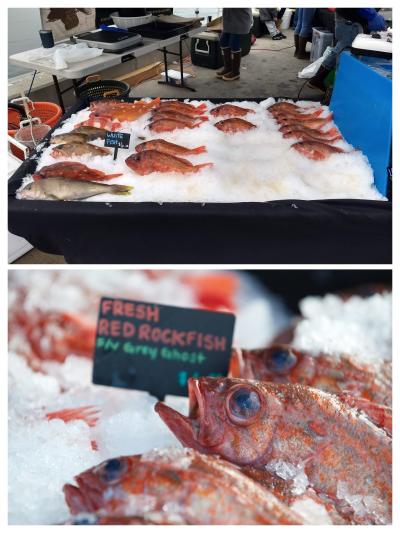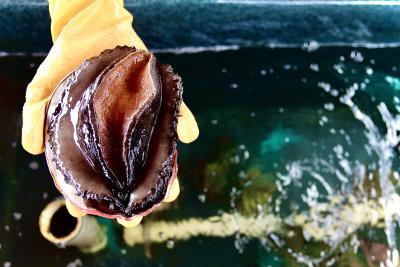California Sea Grant recently launched a new interactive website that helps seafood lovers find fresh wild-caught and farmed seafood straight from the source.
The online directory highlights markets where fishermen and farmers are selling their own fresh-caught and harvested seafood directly to consumers.
These markets are great places to go to find fresh and live local seafood. You can find staples like rockfish and crab, seasonal offerings, or delicacies such as farmed “Balthazar” giant abalone. These markets provide seafood directly from producer to consumer, so shoppers know who and where the seafood is coming from.
How does it work?
Shoppers can use the online map to locate fishermen’s markets, off-the-boat and at-the-farm sales locations, and farmers' markets featuring direct producer-to-consumer seafood sales in your area.
They can search the interactive map by the market type tabs, the map icons or by entering a county. Before visiting a market, click on the more information link to learn about vendors, products and how and when to purchase the seafood.
Carolynn Culver, an Aquatic Resources Specialist with CA Sea Grant and collaborator on the website database, sees the benefits and growing popularity of these markets and expects to add many more to the map in coming years.
She hopes people will use this new resource to discover the great variety of seafood produced in California and the ever-growing network of local, straight-from-the-source locations to obtain it.

Photos by Carrie Culver, Fred Greaves for California Sea Grant
More than a market
One of the oldest operating fishermen’s markets dates back to the late 1800s, but these markets and direct seafood sales have seen a boom in popularity in recent years.
Steve Escobar, a seasoned rockfish and lobster fisherman, has sold his fresh catch at the Newport Dory Fishermen’s Fleet Market for over 30 years. He’s experienced this new wave of growth firsthand and said social media is contributing to the influx.
“I used to know 80 or 90% of my customers. I now probably know about 10%,” Escobar said. “There's new people every week.”
While many people visit these markets for fresh seafood, the relationships formed and stories told are just as vital to the experience.
Doug Bush, manager of The Cultured Abalone Farm in Goleta, has sold his products at the Santa Barbara Saturday Fishermen's Market for nearly 15 years, offering farmed red abalone and “purple hotchi” (purple sea urchin uni). He describes his niche clientele as “people who are very interested in where food comes from and are nostalgic about abalone specifically.”
“Going down and picking abalone off the rocks, pounding them on the rocks and cooking them over an open flame with your buddies, that was something that existed in a sort of nostalgia-driven version of the California days of gone,” Bush said.
After a long history of sustainable use by California’s coastal Indigenous peoples, commercial and recreational fishing and disease resulted in major declines. With harvesting of abalone now prohibited in California, you’ll have to turn to farmers like Bush to dine on this aquatic delicacy.
Sustainable fishing and farming
Seafood producers note that these small local markets supports sustainable fishing and farming practices. And having a wide variety of seafood to pick from at these markets benefits both shoppers and sellers.
Santa Barbara’s fishermen’s market “doesn't represent the global overfishing crisis,” according to Bush.
Trusting each other to show up every week and provide a diversity of offerings is the way they get foot traffic, he said.
“We rely on each other,” Bush said.

Photo courtesy of Roxanne Hoorn.
Escobar appreciates the higher profits of selling live crab and lobsters directly to eager clients without a middleman. It allows him to take less and still make a profit, promoting a sustainable and long-term focused fishing practice.
When it comes to his harvest, Escobar’s motto is “keep it small, keep it all.”
At the end of a long work week, these markets aren’t just a place to buy food, but a space to find community and celebrate the bounty of California’s Pacific waters.
If you are or know someone who is a California-licensed commercial fisherman or registered aquaculturist who sells their seafood directly to consumers from their boat/farm or at a fishermen’s or farmers’ market not listed in the finder, please reach out and let us know. CA Sea Grant is dedicated to making this resource as comprehensive and inclusive as possible - getting the freshest seafood straight to your plate.
Acknowledgments
Design: M. Robinson, UC Santa Barbara (UCSB) and California Sea Grant (CSG) Affiliate.
Content team: C. Culver, CSG, UCSB and UC San Diego, C. Pomeroy, UC Santa Cruz, and H. McVeigh, CSG, UCSD.
Student Contributors: L. Houk and D. Changlee, CSG, UCSB.
About California Sea Grant
NOAA’s California Sea Grant College Program funds marine research, education and outreach throughout California. Headquartered at Scripps Institution of Oceanography at the University of California San Diego, California Sea Grant is one of 34 Sea Grant programs in the National Oceanic and Atmospheric Administration (NOAA), U.S. Department of Commerce.